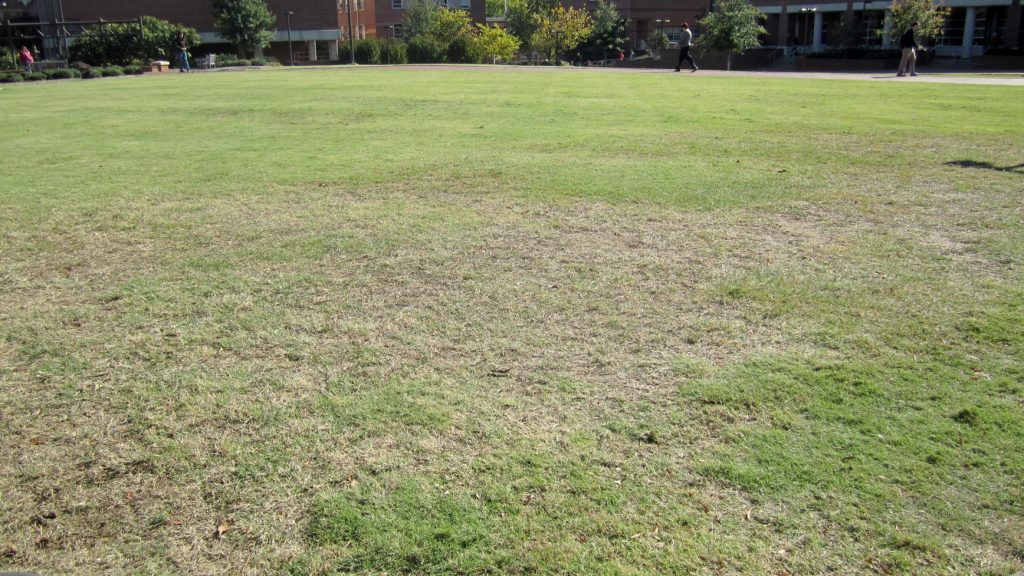Introduction
The sugarcane beetle (Euetheola humilis, family: Scarabaeidae) (Fig. 1) has been an important pest for over 100 years in many crops, including sugarcane, corn, sweet potato, and rice. It is a native species and is commonly found in turfgrass. A low number of beetles in an area is not generally considered a pest. This situation is changing. The adult beetle has been increasing in numbers and causing damage to turfgrass stands throughout the southeastern U.S.
Description
The adult beetle is black with small punctures along the elytra (wing covers), which make up vertical stripes. The adult is about ½-inch long. The first pair of legs have four serrations, enabling the beetle to be a strong digger. As a result, adults have been known to damage asphalt roofs, door gaskets, and other soft structural elements if security lights attract them to buildings. The larvae of this beetle are C-shaped grubs, similar in appearance to other white grub species. The third instar larva can reach up to 1¼ inches long and be identified by a creamy white body with a reddish-brown head capsule.

Life Cycle and Biology
The sugarcane beetle has four stages: egg, larva, pupa, and adult. The beetle overwinters as an adult and emerges in early April. The activity of overwintered adults can be observed from April until early June. During this time, the adults mate, and the females lay eggs in the soil. After the eggs are laid, the spring overwintered adults die. The eggs hatch into white grubs, and about 75 days after hatching, larvae pupate. Larval stages are found from June to August in the soil feeding on roots and organic matter in the soil. It takes from 15 to 20 days for an adult to emerge from the pupa. Grubs have been found up to one foot underground. The activity of summer adults can be observed again beginning in August, they feed through October and then overwinter until spring. There is one generation per year.

Sugarcane beetles (Fig. 2) are primarily found on warm-season turfgrasses, especially bermudagrass and zoysiagrass. Adults are usually active during the early nighttime hours. As daylight breaks, adults attempt to dig away from the sunlight. However, it is known that adult beetles are attracted to lights at night. This characteristic has been used to sample and monitor the beetle. Lighting control or switching to less attractive “bug light” type bulbs may reduce problems in many situations. They can be found within the turfgrass canopy and at the soil surface or just under the surface, feeding on turf roots and crowns. The larvae can be found in similar locations infesting bermudagrass and zoysiagrass. The organic matter in the thatch and roots is the main component of their diet.
Damage to turfgrass is believed to be caused by the adults tunneling and digging, and feeding on the roots. Birds may also cause some damage when they prey on these beetles during the day. Beetle concentrations can exceed 50 per square foot, a density that will destroy turfgrass quickly (Fig. 3). These aggregations are not always closely associated with lights but usually occur in grassy areas with plentiful organic matter in the soil.

Management
An understanding of pest biology is required for the effective management of any insect pests. Unfortunately, the sugarcane beetle life cycle and biology are not well understood. However, it is known that adults are active during April and early June and August through October. Cultural practices, such as reduced irrigation and the use of sodium vapor lights instead of mercury vapor bulbs, may reduce the attractiveness to turf during adult flights.
The use of pyrethroid insecticides, such as bifenthrin (Talstar, Menace, etc.), lambda-cyhalothrin (Scimitar or Battle), deltamethrin (Deltagard), cyfluthrin (Tempo), and other pyrethroids are effective against adults. Application late in the day should be more effective given the beetle’s nighttime feeding habits. A high spray volume (e.g., 75 to 100 gpa) can improve the efficacy of the insecticides. Because the adults are often concentrated in a relatively small area, the application of insecticide on a large area is usually not necessary. Thorough drenching of the affected area may improve insecticidal control, reducing turfgrass damage with minimal cost and insecticide use. In affected areas of bermudagrass and zoysiagrass, if the adults are effectively controlled, the soil can be core aerified to stimulate turfgrass growth from belowground rhizomes. If the infestation is severe, re-soding may be necessary.
References
Billeisen, T. L. and R. L. Brandenburg. 2014. Biology and Management of the Sugarcane Beetle (Coleoptera: Scarabaeidae) in Turfgrass, Journal of Integrated Pest Management, 5 (4) https://doi.org/10.1603/IPM14008